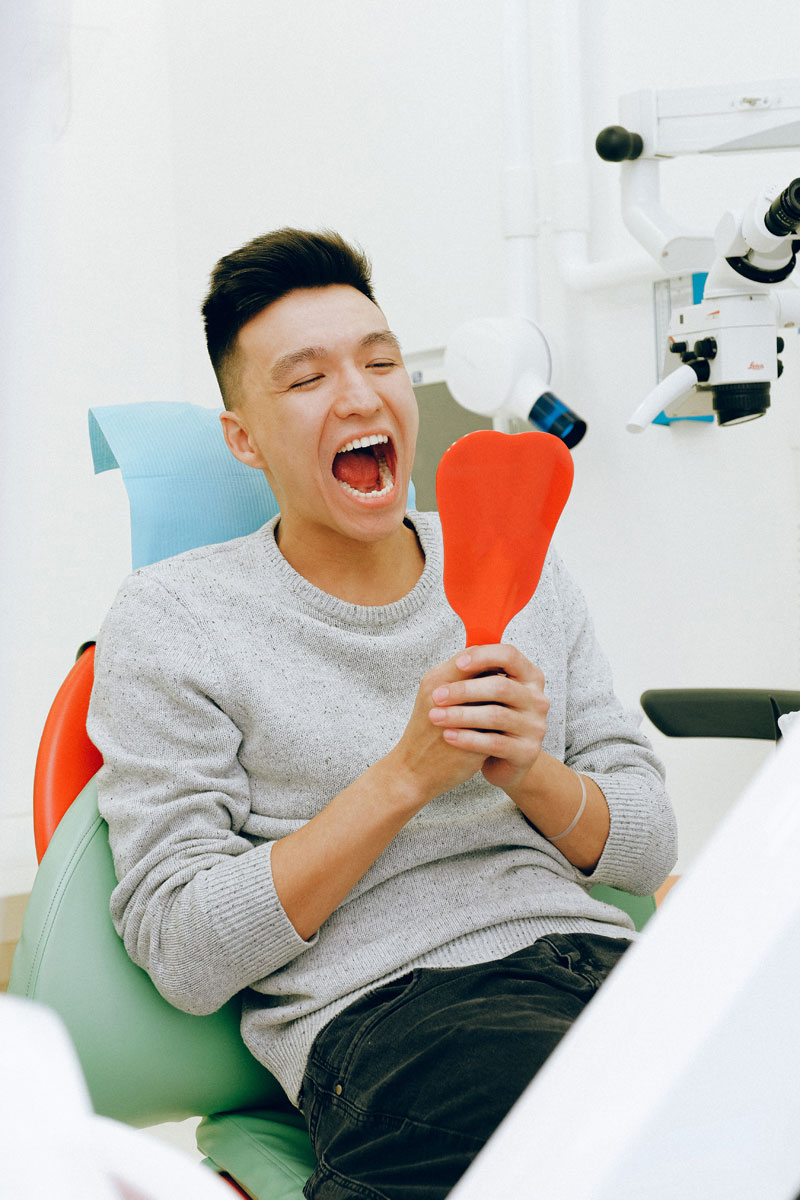
Prosthetic (immobile and mobile)
Tooth cases
The case (crown) is a restoration that covers the entire tooth, when it needs more protection from the chewing forces, due to a crack, fracture, abrasion, denervation or major restoration. The cavities look like natural teeth in shape and color and look like faces with the difference that they cover the entire tooth (all surfaces of the tooth) and not just the front surface.
– What material is the tooth case made of?
There are many materials that can be used to make cases. There are metal-ceramics where the inner part of the case is made of metal and the surface layer is made of porcelain. There are also all-ceramic hoops, which are made entirely of porcelain, and zirconium hoops, which are made of zirconium.
– How to choose the case?
The choice of material is made according to the needs of the patient on a case by case basis.

Bridges
We call a dental bridge the “false” (prosthetic) teeth which fill a gap from a missing tooth. To add this tooth to the empty spot it needs to be supported from the right and from the left by the adjacent teeth, which we call braces. It is an alternative to dental implants for patients who do not want surgery.
Thus, we prepare the adjacent teeth to accept cases that will be joined with the prosthetic tooth that will fill the gap. Alternatively, the prosthetic tooth is glued to the adjacent teeth with a special glue and almost no preparation of the adjacent teeth, only in cases where the occlusal forces are not possible and they can hold it in place for a long time.
The materials used in the bridges are the same as the cases, ie they can be metal-ceramic (metal inside and porcelain outside), all-ceramic (all porcelain) or zirconium.
The result always comes out after consultation with the patient for the desired color, which is in the natural color of the teeth.
Placement of cases and bridges over implants (implant restorations)
An implant is the technical restoration of the root of a missing tooth. Implant restorations are the prosthetic piece that goes over the implant and is the false tooth that will be visible. It is always made in the natural color of the tooth, so that the result is completely natural.
Partial and complete removable dentures
The denture is a denture that consists of technical teeth made in the laboratory and restores lost teeth on the jaw. It is mobile, ie the patient can take it out and put it back in easily and quickly, on his own and can cover some missing teeth or all the teeth, if they are missing from the jaw.
It restores the patient’s smile, confidence, aesthetics, functionality and comfort.
Implanted removable dentures supported by implants
When there is a denture in the mouth, which does not touch well, is not functional and as a result the patient has difficulty speaking, chewing, etc., it can be replaced by an overlapping denture.
Implanted dentures are respectively removable dentures – that is, the patient can remove and reattach them – which rest on implants (2 or 4 depending on the case) or on existing tooth roots, when they are deemed appropriate and healthy.
– Benefit from the use of dentures
The purpose is to improve the quality of life of the patient, who can chew, eat and maintain oral hygiene ina stable denture.
Immediate dentures
When there are a few teeth left in the mouth and they have been diagnosed for extraction, the treatment is the construction of a denture.
Immediate denture is this denture that is placed in the patient’s mouth immediately after extraction, so that it does not remain without teeth for a long time and is temporary. By making the denture before the exports and immediately covering the non-aesthetic gaps, the patient remains active in his professional and social life, without having to wait for the export areas to heal and then to repair the gaps. The teeth are made in their natural color so that the difference is not perceived.
After about 6 months, when the export areas have healed well, there is a normal bone resorption in these areas. As a result, the immediate denture is not as stable and does not hold properly. The solution to this problem is simple, as one filling of the denture (refilling) is enough.
Denture repair
If for some reason you feel pressure in a part of your denture, or even if a wound has been created by this pressure, with a short visit we adjust the denture.
If the denture is broken at some point it can still be easily repaired but it will take some time in the laboratory for the broken spot to be joined or repaired.
Teeth addition to an existing denture
When there is already a denture in the mouth and one or more teeth need to be extracted, it is possible to add artificial teeth on the mouth guard, avoiding the entire replacement.
It is an economical and relatively quick solution.
Retreading (reapplication) of dentures
The condition of the tissues inside the mouth is not stable and they can change over time. Therefore, if your denture doesn’t apply perhaps a fill (retreading) can solve the problem. Consult our doctors!
Protective splints
– Sports protective tooth splints
Sports splints are auxiliary in sports such as boxing, martial arts, extreme sports, basketball, football, volleyball, skateboarding etc. The aim is to protect the teeth but also the cheeks, the lips and the tongue during sports activities.
They are made based on the teeth of each patient, after taking individual imprints, so that it fits correctly and fully protects, in contrast with the masks that you can find on the market.
The material used for their manufacture is vinylso that it can absorb shocks.
– Bruising splints for the treatment of teeth grinding or clenching
Bruxism splints are used to treat crackling or clamping of teeth. It is estimated that about 12-30% of the population end up in bruxism at a time in their lives (Manfredini, et al., 2013).
Bruxism can occur either during a period of stress and anxiety, or due to an occlusal problem (abnormal bite of the teeth), or even disorders during sleep such as apnea.
The diagnosis is often difficult to be made in the early stages, as only from the symptoms we can tell.
Patients who have bruxism, often wake up with headaches around the cheeks and temple, or they astringent their jaw after sleep. The people who sleep with us may realize it earlier as they can hear it.
The dentist can diagnose it after taking full history of the patient, clinical examination of the temporomandibular areas and damage to the teeth.
It is important to address the problem in order to eliminate headaches and joint pains in order to protect the teeth from future abrasions, fractures and breaks that will create over time bigger problems and to eliminate traumatic occlusion.
Solutions are found in bruxing splints, which are customized to apply to the patient’s teeth. In this way, the teeth keep a distance from each other, meaning a more relaxing location for the jaw, as well as restorations and teeth are protected..
Moreover, a way to deal with bruxism is to avoid caffeine consumption, refreshments such as cola, chocolate, alcohol and chewing gums.
– Senate splints
The occlusive splints are made to protect the joint of the jaw from temporomandibular disorders (TMD), including bruising. The problem is located in the joint disc, which does not keep the parallel desirable movement with the tuber, resulting in the movement of the jaw not being smooth. The pressures on the joint are excruciating and cause pain and even inflammation.
= Causes of temporomandibular disorders
The causes of CGT are usually associated with an injury to the jaw, the tuber or surrounding muscles, or even because of bruising, i.e. the creaking or tightening of the teeth.
It may also be responsible for displacement of the joint disc, either to rheumatoid arthritis or osteoarthritis.
= How can I perceive temporomandibular disorder?
The patient can easily perceive this when they hear “clicks” while they open and close the mouth, which can also lead the jaw to “lock”. Also, there may be pain and tenderness around the ear, the cheeks and teeth without other obvious cause. Furthermore, the patient may find it difficult to open his mouth completely and during this movement the jaw moves to one side more.
= How is the diagnosis made by the dentist?
If CST is not a chronic problem, the prognosis is very good. It can be cured under specific instructions as well as using an occlusive splint, made to fit perfectly on the teeth, preventing them from coming into contact, thus relaxing the muscles and drastically reducing the occlusive forces.
Also, with this splint, the teeth are protected from abrasions as well as the already existing restorations. In more serious and chronic incidents other than the splint, special muscle relaxation exercises are recommended. Finally, muscle relaxant medication or surgery may be needed.
Why choosing DENTAL ART
Laser technology.
Emphasis is put on sterilization and cleanliness.
Minimal invasive dentistry.
Digital radiological examination with minimum radiation.
Modern ways to minimize pain.
First visit is free of charge.
Free examination and preventive treatment for people with disabilities.
Affordable prices – flexibility in payment methods.
